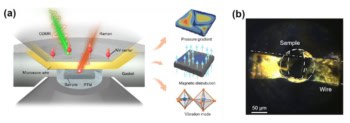Two independent teams have hammered what could be the final nails in the coffin of a mechanism long thought able to explain high-temperature superconductivity.
Since compounds of copper oxide or “cuprates” were first discovered to exhibit superconductivity at temperatures well above absolute zero in the mid 1980s, physicists have tried to explain how these materials behave by adopting the approach used to understand their low-temperature counterparts. This would mean that the signature of superconductivity — a flow of charge with zero resistance — results from electrons interacting with vibrations in the cuprate’s crystal lattice.
It’s a politically charged problem, a little like trying to find the tomb of Jesus Tom Timusk, McMaster University
In recent years, despite mounting experimental evidence against it, some physicists have clung on to this interpretation. But now teams from Germany and the US have performed calculations to suggest that lattice vibrations in cuprates can at best account for just a small fraction of the materials’ superconducting behaviour.
“It’s a politically charged problem, a little like trying to find the tomb of Jesus,” says Tom Timusk of McMaster University in Canada, who is not involved in the research. “An atheist could not care less, nor would a Muslim or a Buddhist be excited, but for believers it would be a monumental discovery. So it is with the phonon mechanism of [high-temperature] superconductivity.”
From low to high
Low-temperature superconductors, which make a transition to the superconducting phase close to absolute zero, have been well described by Bardeen–Cooper–Schrieffer (BCS) theory for 50 years. In this theory, the natural repulsion between two electrons is overpowered by a lattice vibration, known as a phonon, which binds the electrons into a “Cooper pair”. It turns out that at low temperatures an electron can avoid the effect of any resistance by being with its partner, so the Cooper pair does not experience resistance at all.
BCS theory itself cannot explain how electrons pair up in high-temperature superconductors, but physicists — notably Alex Müller, who shared the 1987 Nobel Prize with Georg Bednorz for discovering the materials — have suggested that it might still be some process based on phonons. Although many techniques including neutron scattering and far-infrared spectroscopy have not agreed, in 2001 separate teams performing photoemission spectroscopy found evidence to back up the phonon interpretation.
They found that, after shining light at different angles onto cuprates, electrons emitted by photoionization had an energy–momentum relationship containing a prominent “kink” between 50 and 80 meV. Such a kink implied that the electrons were interacting in the cuprates with some sort of boson (an integer-spin particle) — though it was not clear whether that boson could be a phonon.
Now Dirk Manske and colleagues at the Institute for Solid-State Physics in Karlsruhe and the Max–Planck Institute for Solid-State Research in Stuttgart have calculated how the energy–momentum relationship should look from first-principles calculations to see to what extent phonons can be the cause of the kink. They used a “local density approximation” to calculate the number of energy states available to electrons in the high-temperature superconductor YBa2Cu3O7, which they combined with a calculation of how the electrons should change in energy due to a phonon interaction.
It’s embarrassing for people to admit they have worked on something for 20 years if it is not true Dirk Manske, Institute for Solid-State Physics, Karlsruhe
Small kink
Manske’s team found that the theoretical energy–momentum relationship produced by these calculations did contain a kink — but about a three to five times smaller than the 2001 observations (Phys. Rev. Lett. 100 137001). This is bad news for physicists who have been hoping phonons can account for all of the behaviour of high-temperature superconductors. “It is embarrassing for people to admit they have worked on something for 20 years if it is not true,” jokes Manske.
Meanwhile, Steven Louie and colleagues at the Univerisity of California in Berkeley have come to a similar conclusion with the cuprate LaSrCuO4. From their calculations, the phonon contribution is almost an order of magnitude too small for the observed kink (Nature 452 975).
Although phonons are now effectively ruled-out as the underlying cause of high-temperature superconductivity in cuprates, researchers still have the task of finding another process that works. One possibility is that the electrons pair up via interactions between their spins. Such interactions occur over much shorter ranges than phonons, and in fact there has already been significant evidence to support this notion.
“There are many experimental techniques being used to interrogate the high-temperature superconductors,” says Louie. “With increasingly better samples and advances in experimental techniques, data from these measurements are revealing more and more detailed, systematic results. The correct theory of superconductivity for the high-temperature cuprates will have to consistently explain all these data.”



